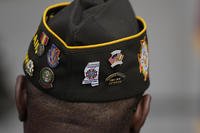The Viking Age spanned from the sacking of the abbey on Lindisfarne in June 793 and is generally accepted as ending with William the Conqueror's ascension to the English throne in 1066. The Norse traveled outward from Scandinavia, reaching everywhere from Estonia to Canada to Spain to Baghdad. Despite their many accomplishments in exploring and trading, history knows them as warriors who welcomed battle and death.
No Viking warrior has a reputation for badassery quite like that of Ragnar Lothbrok. His lifestyle was so badass that it's been made into a television series on the History channel, aptly named “Vikings.” According to the show, Lothbrok single-handedly led the assaults on Lindisfarne, Paris and Wessex, and his eventual death sparked his sons to form the Great Heathen Army.
Looking at the timeline of those events in the real world, that would mean he had a roughly 73-year Viking career. The Vikings, historically, made those victorious raids in 793, 845 and 858 before his death in 865. While it's not entirely impossible for someone to raid for 73 years, the show's creators are open about their creative liberties. The biggest of them being that there may have been many people named Ragnar Lothbrok -- or no one at all.
The Norse weren't keen on preserving their own history. They did tell stories orally, which is how they still exist today, but historical records kept by the Vikings are scarce at best. As with most stories, there was room for exaggeration. Plus, the people who wrote the stories of the Vikings were almost always on the receiving ends of raids, concerned more with exaggerating their ferocity and triumphs over Vikings than accurately retelling their defeats.
This leads us to the biggest debate surrounding Ragnar Lothbrok: When and where he actually died. Many have claimed responsibility for death; from Carlingford Lough to East Anglia to Anglesey to where the show places his death, Northumbria, everyone wanted to be known for slaying the fearsome Lothbrok. Taking credit for such a victory could ward off potential raids, but there's little proof to back up most of these claims.

The only legitimate source for information on Ragnar Lothbrok is the Anglo-Saxon Chronicle, a collection of documents detailing Anglo-Saxon history originally published around the time Ragnar was said to exist. His name does appear, but there is a debate within the historical community if that’s the same man. The name "Ragnar" has been attributed to several other Norse leaders and not one single badass.
This puts a new perspective on the term "Son of Ragnar," as it might have been more of a title than an actual blood relation. In the television series, many of Ragnar's sons are born from his multiple wives. The two sons who actually have been historically proven to exist are Bjorn Ironside and Ivar the Boneless, both from different mothers. But any stories of their exploits, once again, fall firmly in the "with-a-grain-of-salt" category, seeing as “The Saga of the Sons of Ragnar” is, like much of Viking history, more of a collection of campfire stories than historical evidence.

Though “Vikings” may not be a completely historically accurate telling of events, they do the Vikings plenty of justice by interweaving the vast collection of Ragnar Lothbrok tales and piecing them into a single, compelling, easy-to-follow narrative. The facts are a bit hazy, but it's still one of the more accurate representations of Vikings in modern media. It just takes some liberties with individual characters.
Of course, there was no one assuming the mantle of "Ragnar" at the Lindisfarne raid. The actual Viking, Rollo, who became the first duke of Normandy in the year 911, lived nearly 50 years after Ragnar's death, which means it's impossible for them to be brothers. Even his first wife, Lagertha, may also be more myth than fact.
But on the bright side, the greatest scene in the entire series -- if not television history -- is actually very historically accurate.
More posts from We Are the Mighty:
By the numbers: 6 most battle-proven weapons in the arsenal
How this 20th century viking fought in 13 wars around the world
We Are The Mighty (WATM) celebrates service with stories that inspire. WATM is made in Hollywood by veterans. It's military life presented like never before. Check it out at We Are the Mighty.
Want to Learn More About Military Life?
Whether you're thinking of joining the military, looking for post-military careers or keeping up with military life and benefits, Military.com has you covered. Subscribe to Military.com to have military news, updates and resources delivered directly to your inbox.















